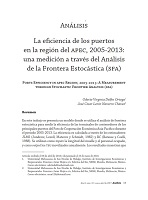La eficiencia de los puertos en la región del APEC, 2005-2013: una medición a través del Análisis de la Frontera Estocástica (SFA)
DOI:
https://doi.org/10.32870/mycp.v6i16.519Palabras clave:
análisis de frontera estocástica, eficiencia, puertos, APECResumen
En este trabajo se presenta un modelo donde se utiliza el análisis de frontera estocástica para medir la eficiencia de las terminales de contenedores de los principales puertos del Foro de Cooperación Económica Asia-Pacífico durante el periodo 2005-2013. La eficiencia es calculada a través de los estimadores: JLMS (Jondrow, Lovell, Materov y Schmidt, 1982) y BC (Batesse y Coelli, 1988). Se utilizan como inputs la longitud del muelle y el personal ocupado, y como output los teu movilizados anualmente. Los resultados muestran que durante todo el periodo analizado en promedio ningún puerto fue eficiente; sin embargo, Shanghái fue el que tuvo los resultados más altos en contraste con el puerto de Callao en Perú, donde sus niveles de eficiencia fueron los más bajos.Descargas
Citas
Afriat, S. N. (1972). “Efficiency estimation of production functions”, International Economic Review, 13(3): 568-598.
Aguilar, R. (2005). “La participación de México en la Cuenca del Pacífico”, De Jure, año 5, segunda época, núm. 2, pp. 155-174
Aigner, D. J. y Chu, S. F. (1968). “On estimating the industry production function”, American Economic Review, 52 (4): 762-782.
Aigner, D. J., Lovell, C. A. y Schmidt, P. (1977). “Formulation and estimation of stochastic frontier production models”, Journal of Econometrics, 6(1): 21-37.
Apec. (2015). Países miembros del apec . Recuperado de http://www.apec.org/about-us/about-apec/member-economies.aspx [10/11/2015].
Apec. (2016). Statistics apec, Key Indicators Database. Recuperado de: http://statistics.apec.org/index.php/apec_psu/index
Batesse, G. E. y Coelli, T. J. (1988). “Prediction of Firm Level Technical Efficiencies with a Generalized Frontier Production Function and Panel Data”, Journal of Econometrics, núm. 38, pp. 387-399.
Batesse, G. E. y Coelli, T. J. (1992). “Frontier Production Functions, Technical efficiency and Panel Data: With Application to Paddy Farmers in India”, The Journal of Productivity Analysis, núm. 3, pp. 153-169.
Bruin, J. (2006). New test: Command to compute new test. Los Ángeles: ucla Statistical Consulting Group. Recuperado de: http://www.ats.ucla.edu/stat/stata/ado/analysis/ [21/10/2015].
Coelli, T. J., Prasada, D., O’Donnell, C., y Battese, G. E. (2005). An Introduction to Efficiency and Productivity Analysis, 2a edición. Estados Unidos: Springer.
Cullinane, K., y Song, D. (2006). “Estimating the Relative Efficiency of European Container Ports: A Stochastic Frontier Analysis”, Research in Transportation Economics, núm. 16, pp. 85-115.
Debreu, G. (1951). “The Coefficient of Resource Utilization”, Econometrica, 19(3): 273-292.
Farrell, M. (1957). “The Measurement of Productive Efficiency”, Journal of the Royal Statistical Society, serie A, 120, parte III, pp. 253-267.
Fergusson, I. F., McMinim, M. A., y Williams, B. L. (2015). The Trans-Pacific Partnership (tpp) Negotiations and Issues for Congress. Washington, dc: Congressional Research Service.
González G. J. (2002). “México y el apec 2002. Recapitulación y perspectivas”, Comercio Exterior, 52(9): 777-788.
Greene, W. H. (1990). “A Gamma-distributed stochastic frontier model”, Journal of Econometrics, 46(1-2): 141-163. Elsevier.
Greene, W. H. (1999). “Frontier production functions”, en: Pesarsan, M. H. y P. Schmidt (eds.), Handbook of Applied Econometric, vol. II, Microeconomics, pp. 81-164.
Greene, W. H. (2003). “Maximum simulated likelihood estimation of the normal-gamma stochastic frontier function”, Journal of Productivity Analysis, núm. 19, pp. 179-190.
Guangqi, S., y Shiping, Z. (2000). “The apec future maritime policy and its evaluation”, Maritime Policy & Management, 27(2): 209-213.
Gujarati, D., y Porter, D. (2010). Econometría, 5a edición. México, df: McGraw-Hill.
Hausman, J. (1978). “Specification Test”, Econometrics, núm. 46, pp. 1251-1271.
Johansen, S. (1988). “Statistical Analysis of Cointegration Vectors”, Journal of Economic Dynamics and Control, 12(2–3): 231-254.
Johansen, S. (1991). “Estimation and Hypothesis Testing of Cointegration Vectors in Gaussian Vector Autoregressive Models”, Econometrica, 59(6): 1551-1580.
Jondrow, J., Lovell, K., Materov, I., y Schmidt, P. (1982). “On the estimation of technical inefficiency in the stochastic frontier production function model”. Journal of Econometrics, núm. 19, pp. 233-238.
Koopmans, T. (1951). “Efficient Allocation of Resources”, Econometrica, 19(4): 455-465.
Levin, A., Lin, C. F., y Chu, C. S. J. (2002). “Unit root tests in panel data: Asymptotic and finite-sample properties”, Journal of Econometrics, núm. 108, pp. 1-24.
Meeusen, W., y Van den Broeck, J. (1977). “Efficiency estimation from Cobb–Douglas production functions with composed error”, International Economic Review, 18(2): 435-444.
Merk, O., y Dang, T. (2012). “Efficiency of world ports in container and bulk cargo (oil, coal, ores and grain)”, oecd Regional Development Working Papers, 2012/09. Oecd Publishing. Disponible en: http://dx.doi.org/10.1787/5k92vgw39zs2-en [12/09/2015].
Montero, R. (2013). Variables no estacionarias y cointegración. Documentos de Trabajo en Economía Aplicada. España: Universidad de Granada.
Morales, J., Araya, G., Serebrisky, T., Briseño-Garmendia, A., y Schwartz, J. (2013). Benchmarking Container Port Technical Efficiency in Latin America and Caribbean: A Stochastic Frontier Analysis. Policy Research Working Paper 6680. The World Bank-Latin American and Caribbean Region-Sustainable Development Department.
Otieno, R., Khin, L., Hualong, Y., y Banomyong, R. (2011). “Sea-Port Operational Efficiency: An Evaluation of Five Asian Ports Using Stochastic Frontier Production Function Model”, Journal of Service Science and Management, núm. 4, pp. 391-399.
Palacios, L. J., González, G. J., y Rangel, D. E. (2006). Las relaciones económicas México-Asia Pacífico en los albores del siglo xxi: Análisis de su dinámica e implicaciones de política. Colima, Colima, México: Universidad de Colima-Facultad de Economía.
Petri, P., y Plummer, M. (2012). The Trans-Pacific Partnership and Asia-Pacific Integration: Policy Implications. Peterson Institute for International Economics Policy Brief, Forthcoming. Disponible en: http://ssrn.com/abstract=2108399
Ragnar, Frisch. (1934). Statistical Confluence Analysis by Means of Complete Regression Systems. Oslo, Noruega: Oslo University-Institute of Economics, publ. núm. 5.
Ramsey, J. (1969). “Test for Specification Errors in Classical Linear Least Square Regression Analysis”, Journal of the Royal Statistical Society, Series B, 31(2): 350-371.
Richmond, J. (1974). “Estimating the Efficiency of Production”, International Economic Review, núm. 15, pp. 515-521.
Rodríguez, E. (2015). “Algunos aspectos del desarrollo económico de Japón y los tigres asiáticos”, Observatorio Iberoamericano de la Economía y de la Sociedad en Japón, 7(22). Recuperado de: http://www.eumed.net/rev/japon/22/desarrollo.pdf [11/01/2016].
Rodríguez, I. (2014). “Nuevas configuraciones económicas en el Asia-Pacífico y sus consecuencias para América Latina: Desde el apec a la Alianza del Pacífico”, Dados - Revista de Ciências Sociais, abril-junio, pp. 553-580.
SE (2012). “Foro de Cooperación Económica Asia-Pacífico (apec). Dirección General de Negociaciones Multilaterales y Regionales”, Memorias Documentales. Recuperado de: http://www.economia.gob.mx/files/transparencia/informe_APF/memorias/12_md_apec_sce.pdf [15/10/2015].
Seitz, W. D. (1971). “Productive Efficiency in the Steam-Electric Generating Industry”, Journal of Political Economy, núm. 79, pp. 878-886.
Shephard, R. (1953). Theory Cost and Production Functions. Nueva Jersey, Estados Unidos: Princeton University Press.
Stata. (2014). Stata Data Analysis and Statistical Software. Recuperado de http://www.stata.com/ [15/06/2015].
Stevenson, R. (1980). “Likelihood functions for generalized stochastic frontier estimation”, Journal of Econometrics, núm. 13, pp. 57-66.
Timmer, C. P. (1971). “Using a Probabilistic Frontier Production Function to Measure Technical Efficiency”, Journal of Political Economy, núm. 79, pp. 776-794.
Traslosheros, G. (2003). “Principales actividades y resultados del apec México 2002”, Informe del presidente de la Reunión de Funcionarios de Alto Nivel de apec México 2002. Secretaría de Economía. Disponible en http://www.protlcuem.gob.mx/swb/work/models/economia/Resource/428/1/images/act02_esp.pdf [22/06/2016].
Waldman, D. (1982). “A Stationary Point for Stochastic Frontier Likelihood”, Journal of Econometrics, núm. 18, pp. 275-279.
World Shipping Council. (2014). Top 50 World Container Ports. Recuperado de: http://www.worldshipping.org/about-the-industry/global-trade/top-50-world-container-ports [10/03/2015]

Publicado
Número
Sección
Licencia
Política de acceso abierto
Esta revista proporciona un acceso abierto a su contenido, fiel al principio de que ofrecer al público un acceso libre a las investigaciones ayuda a un mayor intercambio global del conocimiento.
MyCP se publica bajo la licencia de Creative Commons Reconocimiento-No Comercial CC BY-NC
Los contenidos serán publicados en versión PDF y XML.
Los autores(as) que publiquen en México y la Cuenca del Pacífico aceptan las siguientes condiciones:
De acuerdo con la legislación de derechos de autor, México y la Cuenca del Pacífico reconoce y respeta el derecho moral de los autores(as), así como la titularidad del derecho patrimonial, mismo que será cedido a la Universidad de Guadalajara para su difusión en acceso abierto.
México y la Cuenca del Pacífico no realiza cargos a los autores(as) por enviar y procesar artículos para su publicación.
Los autores(as) pueden realizar otros acuerdos contractuales independientes y adicionales para la distribución no exclusiva de la versión del artículo publicado en México y la Cuenca del Pacífico (por ejemplo, incluirlo en un repositorio institucional o darlo a conocer en otros medios en papel o electrónicos) siempre que indique clara y explícitamente que el trabajo se publicó por primera vez en México y la Cuenca del Pacífico.
Una vez que se acepte el artículo para su publicación los autores(as) deben remitir el formato de carta-cesión de derechos de la publicación debidamente requisitado y firmado por los autores(as). Este formato debe ser remitido en archivo PDF paralelamente con la versión final del artículo al correo: mexicoylacuenca@gmail.com.
Los lectores/usuarios de México y la Cuenca del Pacífico pueden acceder directamente al contenido de manera libre y gratuita en todo momento, incluyendo cuando un nuevo número es colocado en la plataforma. Se permite al lector/usuario citar, compartir (electrónicamente y de manera física), imprimir y distribuir el material siempre que se indique de manera clara y explícitamente que el trabajo se publicó por primera vez en México y la Cuenca del Pacífico. Es necesario citar de manera correcta el trabajo y no debe de ser utilizado con fines comerciales.




